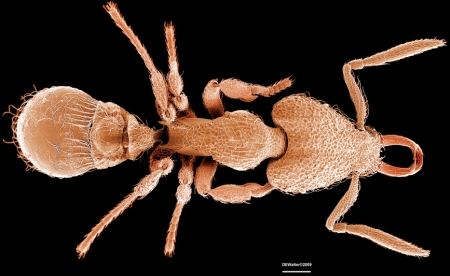Over at MyrmecosBlog there is an interesting example of why Wikipedia isn’t a good idea as a reference source. Whatever their proper name, and I always thought of this Queensland rainforest ant as a Strumigenys, I think this is one of the ants in question. Of course, relying on Macromite as a source of ant identifications is about as good an idea as using Wikipedia for a term paper, but I thought a post to all those organisms that make themselves more interesting by eating mites was in order. And while I am at it, a doulbe hurrah for the poison dart frogs that gain their noxious toxins from eating both ants and mites.
Re the ant: I can’t remember if this is a black ant or a red ant, but red constrasts with the background. This isn’t a great job of masking, but ants have way too many hairs. If anyone wants to see some better SEMs of ants and their parts, they should check out Roberto Keller’s Archetype Blog.

June 8, 2009 at 9:43 pm |
This is one of those ants that all parties can agree on: it’s definitely Strumigenys. Most species are reddish or yellowish, so you’ve chosen well for the color.
June 11, 2009 at 2:37 pm |
“all those organisms that make themselves more interesting by eating mites”
I won’t use the seldom accurate LOL because I did laugh out loud at that one.
BTW, another blog I read is SV-POW!, the Sauropod Vertebra Picture of the Week, where they take a similar view of things that aren’t sauropod vertebrae, having tags such as “stinkin’ mammals” and “stinkin’ heads”. Of course, while their subjects are vastly larger, their subject is vastly smaller than that of mites.
Beautiful ant pic. I love your choice of colours.
BTW, how has the ugly spring/early summer affected your field work and the mites themselves?
June 12, 2009 at 2:57 pm |
Hi Mike,
I think that the non-spring is going to be tough on the field crews (I’ve heard complaints about frozen soil), but as long as the crews can get the soil sample, I can get my mites. The oribatids in the litter layer that I current ly work on seem to supercool and just sit out the winter under the snow and ice. I’ve taken frozen samples of aspen litter from under the snowpack in February and the mites come tumbling out in the extractor (I use a behavioural extraction system – a light bulb to dry out the sample and force the mites along a humidity gradient). The late spring would affect phenology, but my current project uses only adults. Adult oribatid mites have fairly stable populations, are long-lived [for a mite] and slow developing (most here probably take a couple years to reach adult).
June 16, 2009 at 11:36 pm |
Another environmental question (be warned, if you keep answering informatively, I’ll keep asking): I saw where a bad forest fire situation is in the offing for Alberta. Do fires just knock back all the mites and microarthropods or do you get big changes in the diversity or what types of mites there are?
June 17, 2009 at 4:45 pm |
Hi Mike,
Actually, I can’t answer authoritatively about the effect of fires on the mites in Alberta – too many years when my mind was more free ranging were spent in the rainforest. Australian rainforest doesn’t burn (or it would convert to wet sclerophyll). I’ll give it a go, though.
Most of the mites here would be in the litter layers and if these burn to bare ground, then most of the mites will go up too. I can’t remember seeing any studies that support this idea, but there is a study on the effects of clear felling (Lindo & Visser 2004 Can J For Res 34: 998-1006) and oribatid mites were reduced, presumably because of litter reduction and increased moisture stress. In systems that burn frequently, e.g. chapparal in California, the litter layer tends to be sparse and mite populations tend to be centered lower in the mineral soil. Even a centimetre or two of mineral soil can be an effective insulator against a rapidly moving fire, so the effects on the mites tend to be minimal. In Alberta in a spruce, aspen, or pine (probably in that decending order of effect) forest, I expect the mites will be mostly incinerated except under logs and in other pockets or unburned litter. Jack pine is fire maintained, typically on sandy soils, so I expect the mites come through best there. I think aspen burns on a longer fire rotation – probably a century or so based on local records (although fire suppression has probably increased this term). In any case, if we don’t get some decent rain soon, I may be able to give you some real data – my benchmark site is aspen forest that is dry as a bone. I’ve recorded about 75 species of oribatids there and I wonder how many would come through what would probably be a pretty hot fire.
June 19, 2009 at 11:49 pm |
Thanks!